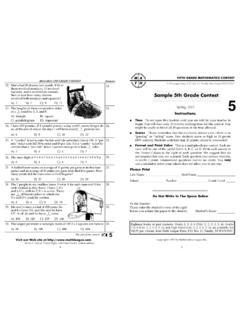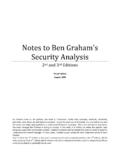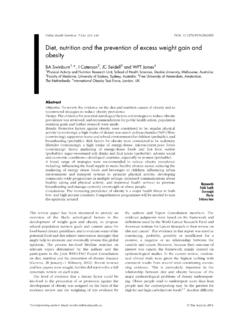Transcription of Georgia Standards of Excellence Curriculum …
1 These materials are for nonprofit educational purposes only. Any other use may constitute copyright infringement. Georgia Standards of Excellence Curriculum Frameworks GSE Grade 6 Unit 1: Number System Fluency Mathematics Georgia Department of Education Georgia Standards of Excellence Framework GSE Grade 6 Mathematics Unit 1 Mathematics Grade 6 Unit 1: Number System Fluency Richard Woods, State School Superintendent July 2016 Page 2 of 135 All Rights Reserved Unit 1 Number System Fluency TABLE OF CONTENTS OVERVIEW.
2 3 Standards FOR MATHEMATICAL PRACTICE ..4 Standards FOR MATHEMATICAL CONTENT ..4 BIG IDEAS ..5 ESSENTIAL QUESTIONS ..5 CONCEPTS AND SKILLS TO MAINTAIN ..6 FLUENCY ..6 STRATEGIES FOR TEACHING AND LEARNING ..7 MISCONCEPTIONS ..9 SELECTED TERMS AND SYMBOLS ..10 INSTRUCTIONAL RESOURCES/TOOLS ..12 FORMATIVE ASSESSMENT LESSON (FAL) ..12 SPOTLIGHT TASKS ..12 3- ACT TASKS ..13 Geared Up (Spotlight Task) ..15 Counting and Building Rectangles (Spotlight Task) ..20 factors and Multiples Puzzles ..26 Back To School.
3 31 Secret Number ..38 Let s Distribute ..43 Hanging By a Hair (Spotlight Task) ..50 School Fund Raiser ..56 Scaffolding Division Through Strip Model Diagramming (Spotlight Task) ..60 Discovering an Algorithm for Dividing Fractions ..65 The Kool-Aid Kid (Spotlight Task) ..71 Dividing Fractions in Context ..77 Fractional Divisors ..82 Dividing Fractions with Models ..88 Understanding Algorithms ..104 Do It Yourself ..111 Modeling Fraction Division (FAL) ..116 Estimating is the Root of Fluency Addition and Subtraction.
4 117 Where Does the Decimal Go? (Multiplication) ..119 Where Does the Decimal Go? (Division) ..124 Culminating Task: Pick A Number, Any Number ..128 UNIT WEB Georgia Department of Education Georgia Standards of Excellence Framework GSE Grade 6 Mathematics Unit 1 Mathematics Grade 6 Unit 1: Number System Fluency Richard Woods, State School Superintendent July 2016 Page 3 of 135 All Rights Reserved OVERVIEW In this unit students will: Find the greatest common factor of two whole numbers less than or equal to 100.
5 Find the least common multiple of two whole numbers less than or equal to 12. Use the distributive property to express a sum of two whole numbers 1-100 with a common factor as a multiple of a sum of two whole numbers with no common factor. Interpret and compute quotients of fractions. Solve word problems involving division of fractions by fractions using visual fraction models and equations to represent the problem. Fluently divide multi-digit numbers using the standard algorithm. Fluently add, subtract, multiply, and divide multi-digit decimals using the standard algorithm for each operation.
6 At each grade level in the Standards , one or two fluencies are expected. For sixth graders the expected fluencies are multi-digit whole number division and multi-digit decimal operations. Procedural fluency is defined by the common Core as skill in carrying out procedures flexibly, accurately, efficiently and appropriately . Students may not achieve fluency within the scope of one unit but it is expected the fluency will be obtained by the conclusion of the course. In the past, fraction and decimal computation have been dominated by rules but research-based best practices have proven that students who are taught to focus on the pencil-and-paper rules for decimal computation do not even consider the actual values of the numbers.
7 Therefore a good place to begin decimal computation is with estimation. It helps children to look at answers in terms of a reasonable range. Although the units in this instructional framework emphasize key Standards and big ideas at specific times of the year, routine topics such as estimation, mental computation, and basic computation facts should be addressed on an ongoing basis. Ideas related to the eight practice Standards should be addressed constantly as well. To assure that this unit is taught with the appropriate emphasis, depth, and rigor, it is important that the tasks listed under Evidence of Learning be reviewed early in the planning process.
8 A variety of resources should be utilized to supplement this unit. This unit provides much needed content information, but excellent learning activities as well. The tasks in this unit illustrate the types of learning activities that should be utilized from a variety of sources. Standards ADDRESSED IN THIS UNIT Mathematical Standards are interwoven and should be addressed throughout the year in as many different units and activities as possible in order to emphasize the natural connections that exist among mathematical topics especially with respect to fluency.
9 Georgia Department of Education Georgia Standards of Excellence Framework GSE Grade 6 Mathematics Unit 1 Mathematics Grade 6 Unit 1: Number System Fluency Richard Woods, State School Superintendent July 2016 Page 4 of 135 All Rights Reserved Standards FOR MATHEMATICAL PRACTICE 1. Make sense of problems and persevere in solving them. Students make sense of real-world fraction and decimal problem situations by representing the context in tactile and/or virtual manipulatives, visual, or algebraic models. 2.
10 Reason abstractly and quantitatively. Students will apply the constructs of multiplication, division, addition, and subtraction of rational numbers to solve application problems. 3. Construct viable arguments and critique the reasoning of others. Students construct and critique arguments regarding the portion of a whole as represented in the context of real-world situations. Students explain why they do not always get a smaller number when dividing with fractions and decimals. Students have to reason the steps in modeling division of fractions.














